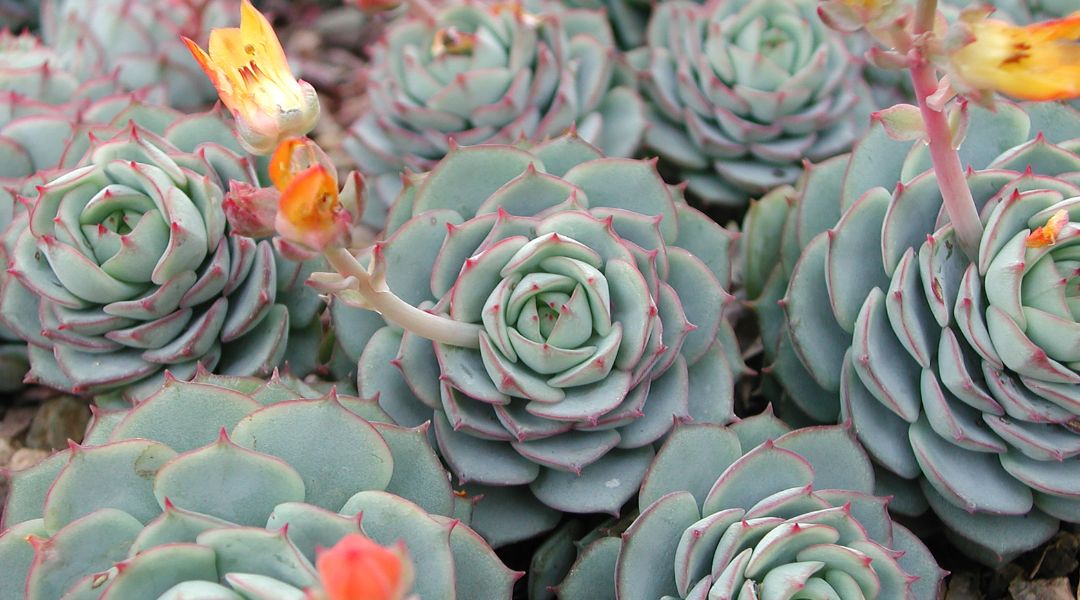Succulents are drought tolerant, sun loving, garden gems. In previous posts, I’ve discussed other succulents like sedum, euphorbia and aeonium. Now, it’s time to share my love for echeveria!
The little florets pictured below are all various types of echeveria. Beautiful, aren’t they?
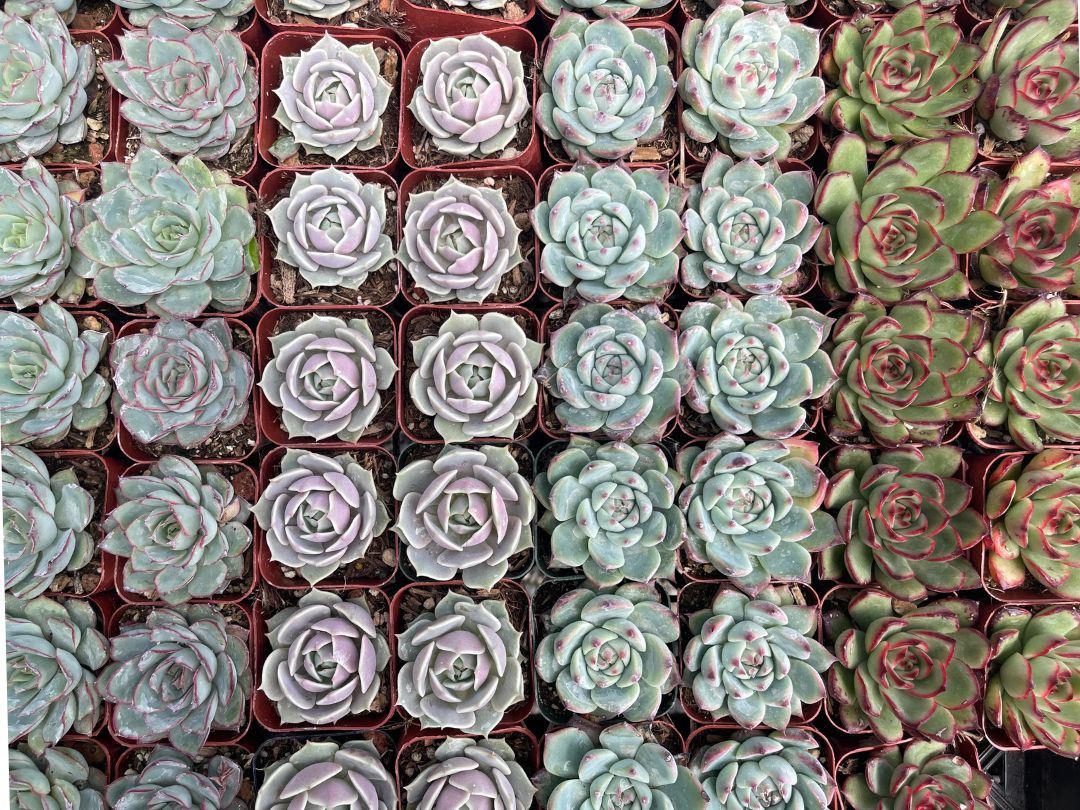
Echeveria Overview
There are over 150 species of echeveria. These species have been crossed to create over 1,000 cultivars of different colors, slightly different shapes, textures and sizes.
The classic types of this succulent are blue-gray or gray-green in color. Now, thanks to hydridizers, you can find echeveria in green, purple, and even variegated varieties. Some types of echeveria show their color more as they age, and others need sun to reach their colorful potential.
Size ranges:
Echeveria plant sizes typically fall between 2-24” tall and 2- 24” wide. On the larger end, there’s an echeveria called Echeveria ‘Blue Dude’ whose pale-blue rosettes get to 18- 24″ wide (I’ve never seen it, but I have so many ideas of how I’d like to use a big, cool blue succulent). The largest species of echeveria, Echeveria gibbiflora, can get up to 3’ tall and wide.
Echeveria is usually a fast growing succulent, growing up to 6- 8″ in one year. Which means most of these succulents will reach full size in one to two years.
When thinking about this plant’s size and shape, you do need to take into account the mounding as the plant creates offsets. Also known as “Mexican Hens & Chicks,” echeveria can produce new offsets, or “chicks,” on stolons around the base of the mother plant.
Here are 3 easy ways to get more plants from your one echeveria:
- Leave the small baby echeveria (the “chicks”) to form a tidy cluster around your original plant (the “hen”).
- Remove and transplant the chicks to create a new echeveria plant (which, in turn, will create more young chicks).
- Propagate new echeveria from stem cuttings or from mature leaves.
A sweet surprise:
One unexpected delight you may get from your echeveria is its magical flower (the flowers of succulents often surprise people). Echeveria looks like a friggin’ flower to begin with—and then you get this long stalk with small colorful flowers! To top it off, most of these flowers attract hummingbirds.
Care tips:
To maintain their colors and compact rosette form, echeveria need bright sunlight. There is often the complaint about echeveria getting “too leggy.” This is the rosette of the plant searching for more sun. This stretching is called etiolating.
Echeveria will not survive a hard frost, but if there is a risk of freezing temperatures they can be brought indoors to grow on a sunny window sill or under a grow light. Thankfully, this succulent makes a great potted plant, both indoors and out.
Like most succulents, they need great drainage and infrequent water. Too much water at the roots of this plant will create rot. When potted, you need to pick containers that have drainage holes at the bottom and use a well draining cactus or succulent soil mix. You don’t want the soil to be soggy. Here’s what to do:
- Don’t water your echeveria too often—allow the soil to dry between waterings
- When you do water your echeveria, water it deeply enough for water to run out the bottom of the pot
- Take care not to let water sit between the leaves, which can also cause the plant to rot
- Remove any dead leaves from the bottom of the rosettes regularly to ward off pests such as mealy bugs
13 Echeveria Varieties & Hybrids
Echeveria ‘Afterglow’
This is my go-to echeveria type. It’s an incredibly beautiful and eye-catching succulent in the garden. It gets bigger than most echeveria and has striking—I’d even say glowing!—pale-pink and lavender colored leaves.
The large and relatively thin spoon-shaped leaves are arranged loosely in an open rosette, giving the appearance of a year-round blooming flower.
The rosette of Echeveria ‘Afterglow’ is said to get up to 1-2’ tall and wide. My observations have maxed the plant out at about 18” wide and about 1’ tall (in the picture below, the echeveria is getting a lift from the agave behind it).
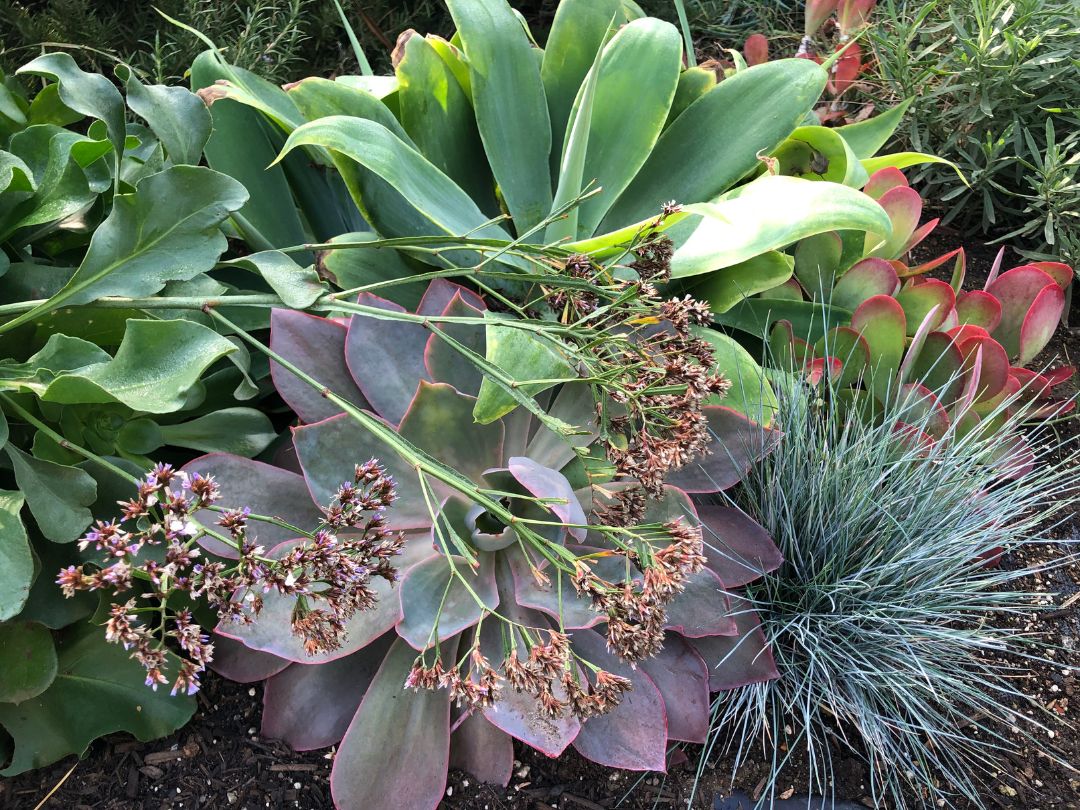
In the garden pictured above, the Echeveria ‘Afterglow’ is complemented with the blue of fescue grass and the green of the agave and statice leaves. One of the things I love about this combination is the play of the purple in the statice flowers with the purple in the leaf of the Echeveria ‘Afterglow’.
This succulent also produces lovely little orange-red flowers in the summer.
There are many, many other echeveria types to choose from. One of my go-to nurseries has a nice selection. There’s nothing like seeing a plant in person to get a sense for it, but let’s see if I can give you a good feel for some of these succulents here.
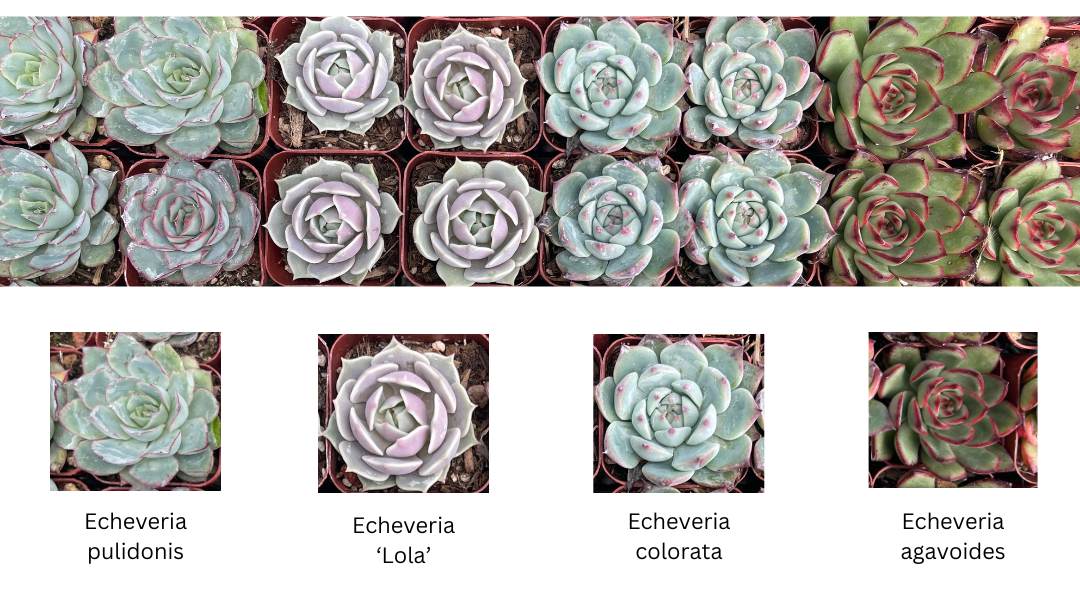
Echeveria pulidonis
I believe I said most echeveria types are fast growing. This echeveria, known as Pulido’s Echeveria, is not. You will have to be patient as it spreads out to its well-formed 6-8” width and 8” height. But don’t think this plant will stop there! This easy-to-grow plant offsets readily to form a good sized clump over time.
These succulents have plump, pale blue-green, oblong leaves with red at the edges and tip. When grown with enough sun, this beautiful contrast becomes even more noticeable as the plant ages. It blooms in the spring, with bright yellow flowers decorating tall, arching reddish stems.
Echeveria pulidonis was a winner of the Award of Garden Merit of the Royal Horticultural Society (RHS). This award was established to help gardeners choose the best plants for their garden. Clearly, it’s not a shabby variety.
Echeveria ‘Lola’
Echeveria ‘Lola’ is a hybrid from the famed echeveria hydridizer Dick Wright. The hybridization is what give ‘Lola’ its quotation marks, showing the plant is a cross between genomes. A variety is usually a natural plant mutation.
Echeveria ‘Lola’ is a subtle yet colorful succulent with beautiful light purple, pink, grey, and blue hues. Its perfectly shaped rosette has a small profile, getting 3-5” high and 4-6” wide.
Like some of the other echeveria, ‘Lola’ has a layer of farina (an epicuticular wax coating), which gives the rosette a pearlescent marble appearance. Echeveria ‘Afterglow’ also has this wax coating, creating a sheen that adds a glow to the plant.
Echeveria ‘Lola’ has yellow and pink bell shaped flowers in the spring.
Echeveria colorata
This beautiful echeveria variety grows 8” tall and 6” wide. Echeveria colorata’s extra-plump leaves are a cool minty green with pointy pink tips. The flowers are slender and colorful, with a pink stem, and a bloom with yellows, oranges, and reds.
There are hybrids of Echeveria colorata that can get larger. Hybridizers have gone to town on this succulent!
Echeveria agavoides
That’s a mouthful. The name agavoides (ah-gav-OH-des) refers to the plant’s resemblance to a (very small) agave. This succulent grows 4-5” tall and 6-12” wide.
Agavoides is a stemless succulent with a rosette made up of triangular-shaped, apple lime green leaves lined with red at the margins. Sometimes these darker tips are bronze or dark brown. This Echeveria agaviodes pictured in the collage above looks to me like a ‘Lipstick’ variety.
In the spring and early summer, pinkish-red or orange flowers tipped with dark yellow appear on foot long stalks.
Okay, we’ve covered five echeveria varieties so far. Let’s keep going!
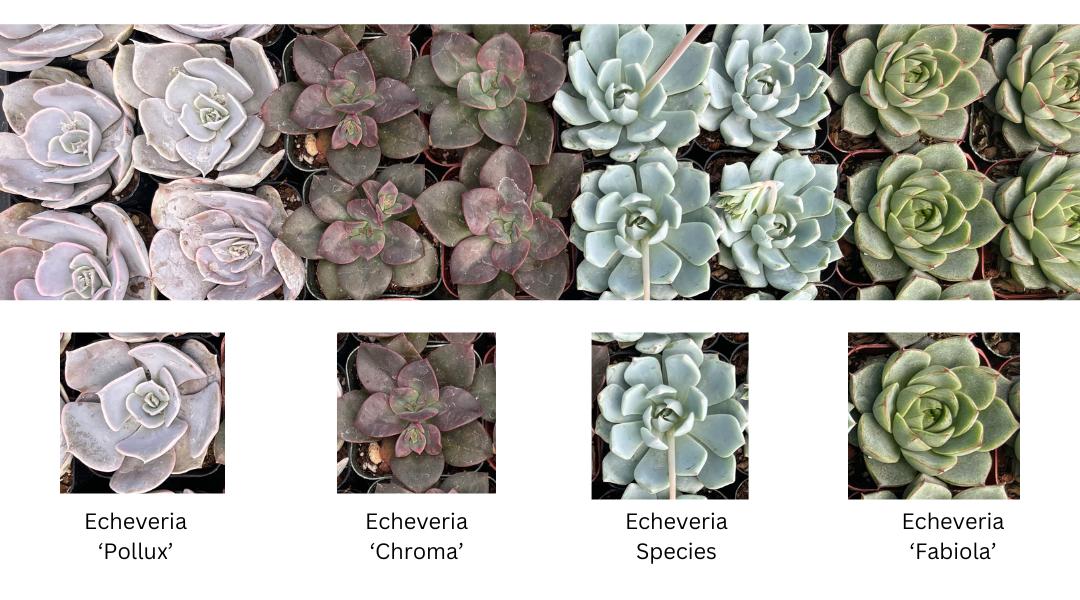
Echeveria ‘Pollux’
Echeveria ‘Pollux’ is a lovely echeveria hybrid that forms rosettes of broad, acutely-tipped silvery-grey leaves that take on a slight lilac blush when exposed to bright light or direct sun. Obviously this nursery gave them enough sun. The farina on these leaves gives this plant a soft pastel look. The rosettes grow up to 8″ in diameter.
The flowers of Echeveria ‘Pollux’, which usually appear in the summer, are bell-shaped with a pink exterior and orange interior.
Echeveria ‘Chroma’
Echeveria ‘Chroma’ forms stunning rosettes of multi-hued leaves that are said to resemble a sunset! Depending on how much light it gets, the colors of the rosette can may be blue, purple, pink, orange, or even a metallic brown. The colors even shift with the seasons. In the collage photo above, this succulent is a green with deep purple edges. To get the full color display from this plant, give it lots of sun. (I should add here that there IS such a thing as too much sun for these succulents.)
Echeveria ‘Chroma’ grows 5” tall and gets 8” wide, with a tall bloom stalk from which yellow, bell-shaped flowers emerge in the spring.
Echeveria Species
Ok, Echeveria Species is not the actual name of a an echeveria variety. In the collage photo above, I just went with how the plant was labeled at the nursery where I snapped the photo. I can only imagine that they gave up trying to figure out which of the hundreds of blue echeveria this one was! If I had to name it, I might go with Echeveria ‘Arctic Ice’. Regardless, I can think of many uses for a blue succulent like this one. Take a look at the photo below, for example.
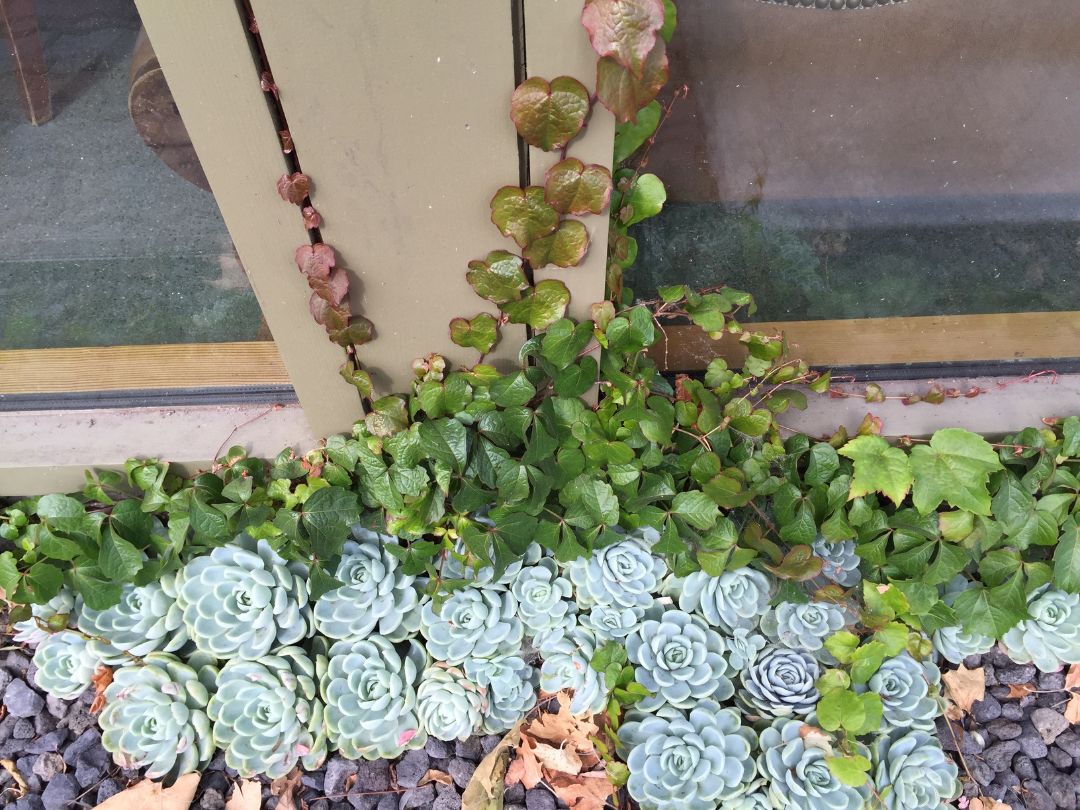
I love the simplicity of a colony of blue echeveria contrasting with dark rocks and green ivy. If I had to replicate the planting pictured above, I would choose Echeveria ‘Abalone’.
Echeveria ‘Fabiola’
Echeveria ‘Fabiola’ is an attractive small and compact succulent. The leaves are thick, fleshy, pale sea green with a thin red line at the tip. The rosettes grow up to 4” in diameter and slowly produce offsets near the base.
The flowers of this echeveria variety are bell shaped—pinkish-red on the outside and salmon orange on the inside—and appear on 6” reddish stems during the summer.
That’s nine varieties of delightful echeveria so far! I’m going to talk about four more varieties (to make a baker’s dozen) before I wrap up this post.
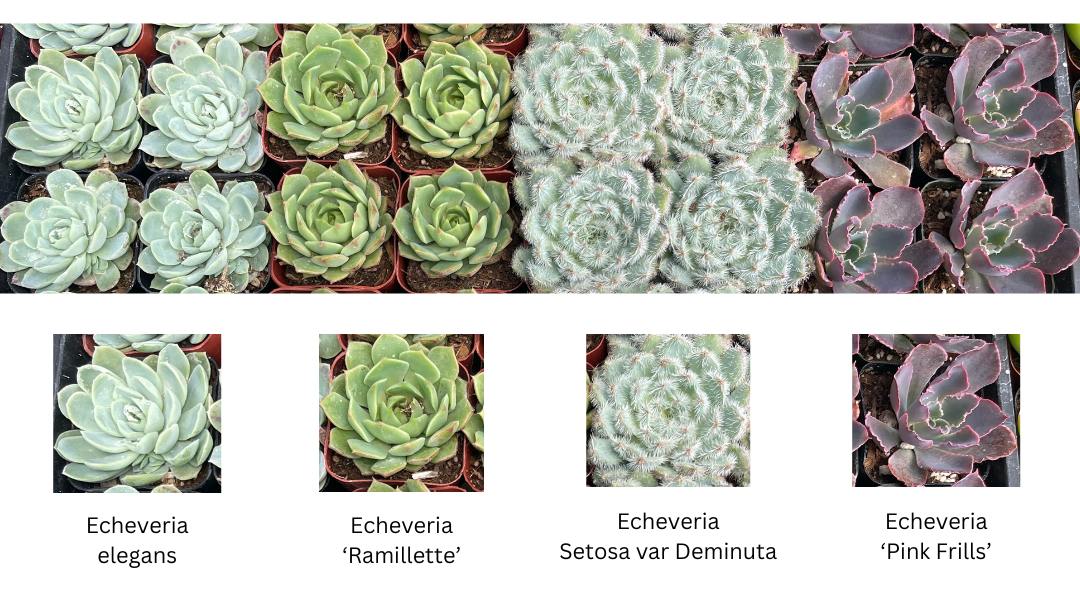
Echeveria elegans
Echeveria elegans is another recipient of the prestigious Award of Garden Merit of the Royal Horticultural Society! Also known as Mexican Snowball, this echeveria variety has fleshy, spoon-shaped, pale silvery-green leaves. The bright flowers have pink-red stems with lantern-shaped pink flowers tipped with yellow.
Echeveria ‘Ramillette’
This freely propagating succulent will cascade off planters with its offsets. A Dick Wright echeveria hybrid from the ’70s, Echeveria ‘Ramillette’ has a compact green rosette that only reaches 3” in diameter. It blooms with bright, yellow-orange flowers.
Echeveria Setosa var Deminuta
Echeveria Setosa var Deminuta is a pale-blue, fuzzy piece of wonder! Also known as Mexican Firecracker, this is yet another echeveria that won the prestigious Award of Merit of the Royal Horticultural Society (well, its parent, Echeveria Setosa, was). The “Firecracker” part of the name is because of the flower. In late spring, this little plant shoots a colorful flower about a foot off the ground. The long stock holds urn-shaped flowers which, on some Setosa, are red and tipped in yellow.
This variety grows about 2-3” high and 3-4” wide, but will develop offsets creating a mounding plant. (Quick side note: This business of getting the various echeveria types identified correctly is tricky! When you look up Echeveria Setosa var Deminuta online, many websites will show you a smaller, less hairy plant—which is very likely an Echeveria setosa var. minor.)
Echeveria ‘Pink Frills’
More specifically, this plant is called Echeveria shaviana ‘Pink Frills’. What a specimen! It almost looks like a flower within a flower.
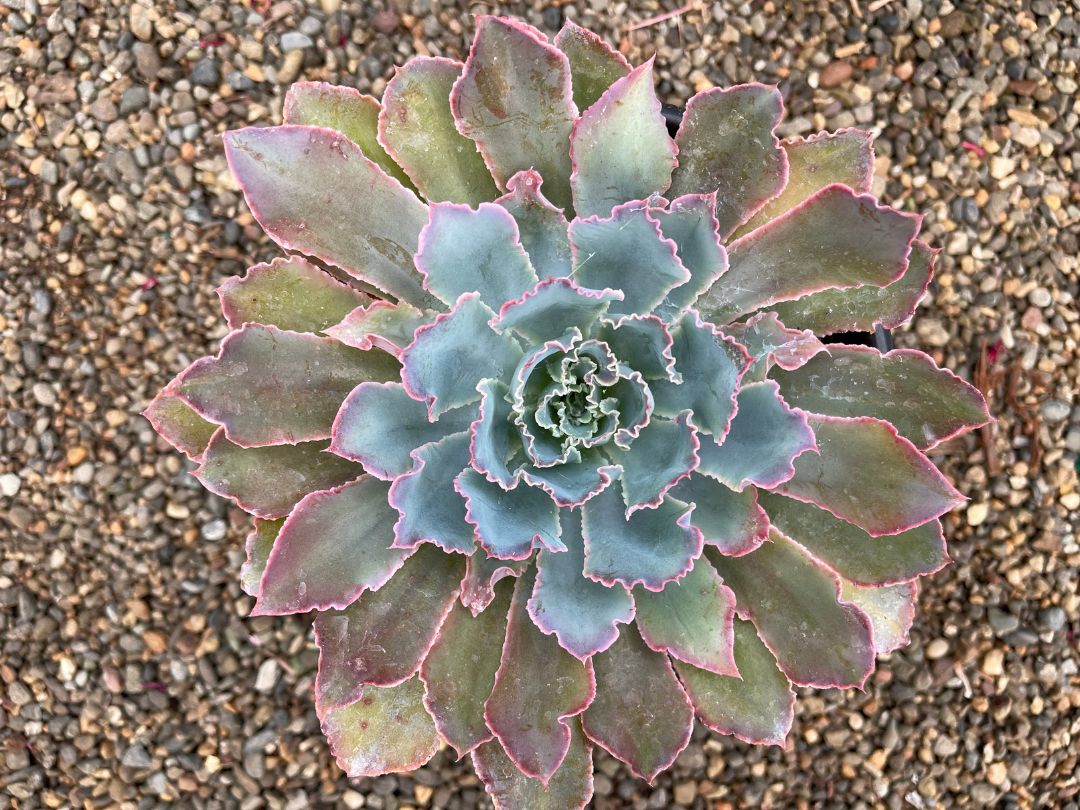
Echeveria ‘Pink Frills’ has greenish purple-silver leaves that are wrinkled pink at the edges. You can just notice it in the nursery picture (the collage photo further up the page), but it becomes more noticeable as the plant ages. The leaves become more of a bluish-green color and the pink margins with ruffled edges or “pink frills” really start to pop.
This nice sized echeveria hybrid reaches about 8” tall and 12” wide. In summer, Echeveria shaviana ‘Pink Frills’ produces small, purple, bell-shaped flowers that open up into a vibrant orange-pink bloom.
Echeveria Combos for Your Garden or Home
At this point, I hope I’ve convinced you that echeveria are lovely plants to combine and add to your garden or indoor container.
Check out the photo below to see some echeveria combos I love:
- First row: Echeveria ‘Afterglow’ with lots of (blue) Echeveria Species (think Echeveria ‘Arctic Ice’).
- Second row: Echeveria ‘Pink Frills’ with lots of Echeveria Setosa Deminuta.
- Third row: Echeveria ‘Lola’ with lots of Echeveria ‘Chroma’
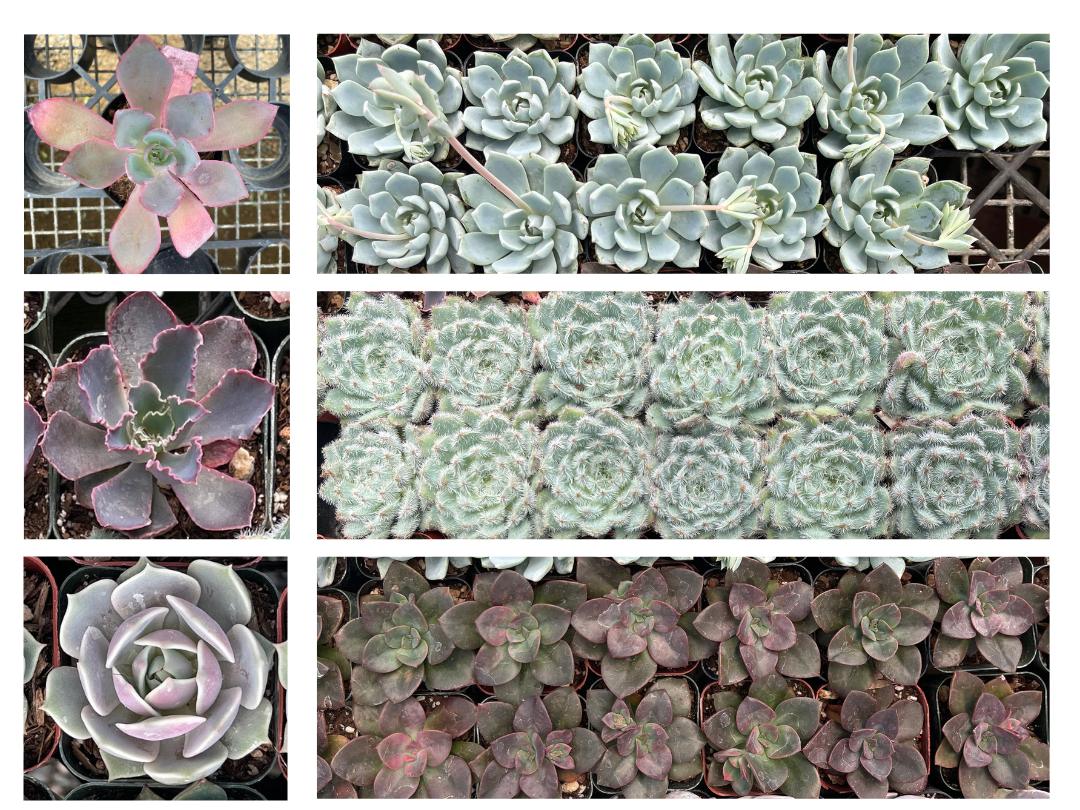
xr:d:DAFrS62nnng:31,j:2963793552954907441,t:24041600
Seeing the plants in the nursery is very useful, but you should also know what your options are. Because one nursery is not going to carry every variety of this plant.
My two go-to nurseries for finding echeveria varieties are Monrovia and San Marcos Growers. It’s basically like going to your favorite boutique—they have a fine eye for some nice pieces, or in this case, specimens. San Marcos Growers also has a list of new plants every year. Its 2023 list includes two new echeveria.
I feel like I hit the motherlode recently when I found Mountain Crest Gardens online. They have over 268 echeveria for you to choose from. Including Echeveria ‘Blue Dude”.
Happy echeveria hunting!
We partner with select companies whose products and/or services we love. Some of the links on this page may be affiliate links. If you purchase an item using our affiliate link, we may receive a small commission (at no added cost to you). We appreciate your support.

